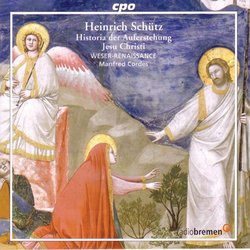| All Artists: Heinrich Schutz, Manfred Cordes, Weser-Renaissance Title: Heinrich Schütz: Historia der Auferstehung Jesu Christi Members Wishing: 0 Total Copies: 0 Label: Cpo Records Release Date: 5/17/2005 Genre: Classical Styles: Opera & Classical Vocal, Chamber Music, Historical Periods, Baroque (c.1600-1750), Classical (c.1770-1830) Number of Discs: 1 SwapaCD Credits: 1 UPC: 761203702725 |
Search - Heinrich Schutz, Manfred Cordes, Weser-Renaissance :: Heinrich Schütz: Historia der Auferstehung Jesu Christi
 | Heinrich Schutz, Manfred Cordes, Weser-Renaissance Heinrich Schütz: Historia der Auferstehung Jesu Christi Genre: Classical |
Larger Image |
CD Details |
CD ReviewsSacred Vocal Music of Schütz Movingly Done J Scott Morrison | Middlebury VT, USA | 06/04/2005 (5 out of 5 stars) "Probably the most striking thing about this CD containing performances of some of Schütz's sacred vocal music by Weser-Renaissance Bremen, led by Manfred Cordes, is its utter simplicity and sincerity, coupled with crystal-clear diction of the moving German words from the Gospels. These are performances not only for lovers of early German baroque music, but for listeners who are looking for a moving religious experience (assuming they understand German -- and excellent English translations of the texts are provided). There are four works included: Surrexit pastor bonus, SWV 469; Historia der Auferstehung Jesu Christi, SWV 50; Ich bin die Auferstehung, SWV 324; and Feget den alten Sauerteig, SWV 404. By far the most important (and longest at nearly 43 minutes) is the 'Story of the Resurrection of Jesus Christ', a very early work by Schütz (his second sacred work, preceded only by his familiar 'David's Psalm' of 1619). It is set to a text of the Easter narrative cobbled together from the four Gospels. It features an Evangelist (sung exquisitely here by tenor Hans-Jörg Mammel) and various combinations of voices (singing in unison or simple counterpoint) to convey the words of Jesus, Mary Magdalene, Cleopas, angels, men and women bystanders in the sepulchre, etc. Accompaniment is a simple string group, plus chitarrone, organ and harp, done with simplicity and taste. One has the feeling of being at an ecclesiastical presentation, which indeed is how the work was initially presented by Schütz during an Easter vesper service. The emphasis seems to be on conveying the message of the text. The recording was made in the Stiftskirche, Bassum.
The other three pieces, none of them lasting more than about five minutes, are later works and show a rather more sophisticated (and thus a bit less immediate) nature. Most notable, for me, was 'Weib, was weinest du?' ('Woman, why weepest thou?'), the dialog between Christ on the cross and Mary (John 20: 13-17). There is an ineffable sadness coupled with a growing ecstasy as he contemplates rejoining his Father in Heaven. As far as I know, this is the only recording of 'Historia der Auferstehung' and it is, for me, a real discovery. Recommended. TT=60:20 Scott Morrison" |
